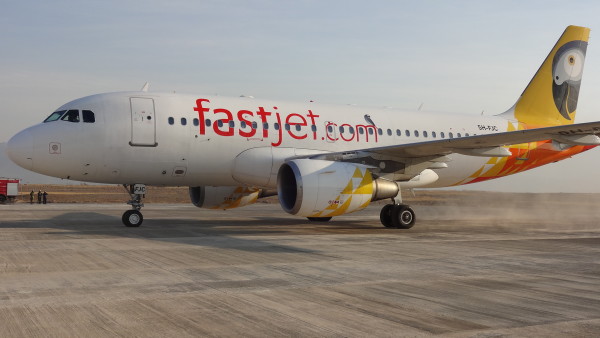Low-cost airlines confront national carriers in Africa

JOHANNESBURG, Sept 16 (Reuters) – Before Fastjet launched low-cost flights between Harare and Dar es Salaam last year, Zimbabwean businessman Jonathan Jabangwe had to brave a hair-raising, three day bus journey to meet his clients in Tanzania.
Fastjet is among a wave of low-cost airlines launching or expanding operations in Africa as they seek to capture middle-income travellers who are tired of dangerous road journeys but cannot afford major international carriers.
The new airlines hope to undercut larger carriers by offering “no frills” services, replicating a model pioneered by European airlines like Easyjet and Ryanair.
Where low-cost routes have opened in Africa, prices have dropped by around 40 percent and passenger numbers have risen by almost half, a study by consultants Intervistas showed.
“It makes a big difference to me. The roads are very slow and you take your life into your own hands,” Jabangwe told Reuters as he queued to catch a flight from Johannesburg.
“Why aren’t these flights all over Africa? With the global economic situation, every dollar counts.”
Africa’s aviation industry is growing at 4.7 percent, faster than any other region and passenger numbers are expected to double to 300 million in the next two decades, according to the International Air Transport Association (IATA).
Growth is, however, off a very low base and widespread expansion of low-cost aviation is hampered by government protectionism, high taxes and stringent regulation.
An “open skies” agreement, similar to the EU pact agreed in the 1990s that led to a boom in low-cost air travel, was signed 28 years ago but has never been properly implemented.
Low-cost airlines say governments block competitors from flying international routes to protect state-owned airlines like Kenya Airways, South African Airways (SAA) and Ethiopian Airlines.
African countries continue to champion national airlines, despite nearly all ventures resulting in losses or bankruptcy.
SAA has been subject to several government rescues in recent years. Kenya Airways posted record losses this year and may need a $500-$600 million bailout, its government said this month.
Nigeria is considering re-launching a state airline and tiny Djibouti said this month it would revamp its previously bankrupt national carrier. The new Air Djibouti will be managed by Iron Maiden rock singer Bruce Dickinson.
If governments were more pro-competition and reforms were imposed it could add $1.3 billion a year in revenue to African economies and create 155,000 jobs, the IATA says.
“PROTECTIONISM”
“Government protectionism is top of the list in terms of what’s inhibiting low-cost aviation moving forward and why Africa is so far behind the rest of the world,” Fastjet boss Ed Winter told Reuters.
Winter says African air fares are on average four times higher than in Europe.
Kenya’s transport minister James Macharia said it had one of the “most open skies in Africa”. South African and Ethiopian regulators did not respond to request for comment.
The lack of government cooperation means most low-cost airlines remain focused on domestic operations in South Africa, home to the continent’s most developed economy.
Comair’s Kulula and South African Airways-owned Mango are well established in South Africa, while FlySafair and Skywise launched their first flights there in the last year.
Comair posted lower profits this week and warned that South Africa was no longer a growth market.
Airlines seeking faster growth in less developed markets are starting to branch out. Fastjet, started by Easyjet founder Stelios Haji-loannou, is based out of Tanzania.
FlyAfrica.com, launched last year, is run from Zimbabwe and announced plans on Aug. 30 to expand routes to destinations in West Africa, the most populated region on the continent but with the least developed flight links.
The biggest missed opportunity is Nigeria, home to Africa’s biggest economy and largest population.
Widespread corruption and mismanagement means West Africa’s Lagos hub is nowhere near as developed as the continent’s other three: Nairobi, Addis Ababa and Johannesburg.
To get from Nigeria to other African countries, it is often faster and cheaper to fly via Europe.
Nigerian President Muhammadu Buhari has yet to appoint a cabinet more than three months after taking office, saying he needs to root out corruption before naming his ministers.
“Nigeria is an anomaly. A huge potential market but very difficult to operate in,” Erik Venter, Comair’s chief executive officer, told Reuters.
“You would expect in a market of that magnitude the likes of a Comair should be climbing in there enthusiastically but we honestly don’t want to touch it,” Venter added.
Yet experts remain convinced that African low-cost aviation will take off, eventually.
Its young population and rising incomes bear similarities with southeast Asia, where low-cost capacity increased four-fold to 200 million in the decade to 2014, according to the Centre for Aviation, a Singapore-based think tank.
“Eventually it will break through but the question is, when?” Brendan Sobie, chief analyst at the Centre for Aviation, told Reuters. “Things can happen fast if the governments start changing policies and the right conditions are there.”
Reuters